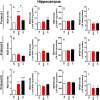A comparative study of the effect of the dose and exposure duration of anabolic androgenic steroids on behavior, cholinergic regulation, and oxidative stress in rats
- PMID: 28594925
- PMCID: PMC5464548
- DOI: 10.1371/journal.pone.0177623
A comparative study of the effect of the dose and exposure duration of anabolic androgenic steroids on behavior, cholinergic regulation, and oxidative stress in rats
Abstract
The aim of this study was to assess if the dose and exposure duration of the anabolic androgenic steroids (AAS) boldenone (BOL) and stanazolol (ST) affected memory, anxiety, and social interaction, as well as acetylcholinesterase (AChE) activity and oxidative stress in the cerebral cortex (CC) and hippocampus (HC). Male Wistar rats (90 animals) were randomly assigned to three treatment protocols: (I) 5 mg/kg BOL or ST, once a week for 4 weeks; (II) 2.5 mg/kg BOL or ST, once a week for 8 weeks; and (III) 1.25 mg/kg BOL or ST, once a week for 12 weeks. Each treatment protocol included a control group that received an olive oil injection (vehicle control) and AAS were administered intramuscularly (a total volume of 0.2 ml) once a week in all three treatment protocols. In the BOL and ST groups, a higher anxiety level was observed only for Protocol I. BOL and ST significantly affected social interaction in all protocols. Memory deficits and increased AChE activity in the CC and HC were found in the BOL groups treated according to Protocol III only. In addition, BOL and ST significantly increased oxidative stress in both the CC and HC in the groups treated according to Protocol I and III. In conclusion, our findings show that the impact of BOL and ST on memory, anxiety, and social interaction depends on the dose and exposure duration of these AAS.
Conflict of interest statement
Figures









Similar articles
-
Impacts of dose and time of boldenone and stanazolol exposure in inflammatory markers, oxidative and nitrosative stress and histopathological changes in the rat testes.Theriogenology. 2017 Mar 1;90:101-108. doi: 10.1016/j.theriogenology.2016.11.024. Epub 2016 Nov 28. Theriogenology. 2017. PMID: 28166954
-
Impacts of dose and length of exposure to boldenone and stanazolol on enzymatic antioxidant systems, myeloperoxidase and NAGase activities, and glycogen and lactate levels in rat liver.Steroids. 2020 Sep;161:108670. doi: 10.1016/j.steroids.2020.108670. Epub 2020 May 27. Steroids. 2020. PMID: 32473164
-
Aggression in male rats receiving anabolic androgenic steroids: effects of social and environmental provocation.Horm Behav. 2001 Nov;40(3):409-18. doi: 10.1006/hbeh.2001.1706. Horm Behav. 2001. PMID: 11673914
-
Early postmortem biochemical, histological, and immunohistochemical alterations in skeletal muscles of rats exposed to boldenone undecylenate: Forensic implication.J Forensic Leg Med. 2021 Oct;83:102248. doi: 10.1016/j.jflm.2021.102248. Epub 2021 Aug 28. J Forensic Leg Med. 2021. PMID: 34478996
-
Anabolic androgenic steroids and aggression: studies using animal models.Ann N Y Acad Sci. 2004 Dec;1036:399-415. doi: 10.1196/annals.1330.024. Ann N Y Acad Sci. 2004. PMID: 15817752 Review.
Cited by
-
Supraphysiologic-dose anabolic-androgenic steroid use: A risk factor for dementia?Neurosci Biobehav Rev. 2019 May;100:180-207. doi: 10.1016/j.neubiorev.2019.02.014. Epub 2019 Feb 25. Neurosci Biobehav Rev. 2019. PMID: 30817935 Free PMC article. Review.
-
Exercise Attenuates Anabolic Steroids-Induced Anxiety via Hippocampal NPY and MC4 Receptor in Rats.Front Neurosci. 2019 Feb 26;13:172. doi: 10.3389/fnins.2019.00172. eCollection 2019. Front Neurosci. 2019. PMID: 30863280 Free PMC article.
-
Androgens augment pulmonary responses to ozone in mice.Physiol Rep. 2019 Sep;7(18):e14214. doi: 10.14814/phy2.14214. Physiol Rep. 2019. PMID: 31544355 Free PMC article.
-
The Behavioral and Neurochemical Changes Induced by Boldenone and/or Tramadol in Adult Male Rats.Neurochem Res. 2023 May;48(5):1320-1333. doi: 10.1007/s11064-022-03827-2. Epub 2022 Nov 30. Neurochem Res. 2023. PMID: 36449200 Free PMC article.
-
Public health impact of androgens.Curr Opin Endocrinol Diabetes Obes. 2018 Jun;25(3):218-223. doi: 10.1097/MED.0000000000000404. Curr Opin Endocrinol Diabetes Obes. 2018. PMID: 29369918 Free PMC article. Review.
References
-
- Lumia AR, McGinnis MY. Impact of anabolic androgenic steroids on adolescent males. Physiology & behavior. 2010;100(3):199–204. - PubMed
-
- Kouvelas D, Pourzitaki C, Papazisis G, Dagklis T, Dimou K, Kraus MM. Nandrolone abuse decreases anxiety and impairs memory in rats via central androgenic receptors. The international journal of neuropsychopharmacology / official scientific journal of the Collegium Internationale Neuropsychopharmacologicum. 2008;11(7):925–34. - PubMed
-
- Tanehkar F, Rashidy-Pour A, Vafaei AA, Sameni HR, Haghighi S, Miladi-Gorji H, et al. Voluntary exercise does not ameliorate spatial learning and memory deficits induced by chronic administration of nandrolone decanoate in rats. Hormones and behavior. 2013;63(1):158–65. Epub 2012/10/17. doi: 10.1016/j.yhbeh.2012.10.003 - DOI - PubMed
-
- Ramos-Pratts K, Rosa-Gonzalez D, Perez-Acevedo NL, Cintron-Lopez D, Barreto-Estrada JL. Sex-specific effect of the anabolic steroid, 17alpha-methyltestosterone, on inhibitory avoidance learning in periadolescent rats. Behavioural processes. 2013;99:73–80. PubMed Central PMCID: PMC3791152. doi: 10.1016/j.beproc.2013.06.004 - DOI - PMC - PubMed
-
- Poling MC, Kauffman AS. Organizational and activational effects of sex steroids on kisspeptin neuron development. Frontiers in neuroendocrinology. 2013;34(1):3–17. PubMed Central PMCID: PMC3725275. doi: 10.1016/j.yfrne.2012.06.001 - DOI - PMC - PubMed
Publication types
MeSH terms
Substances
LinkOut - more resources
Full Text Sources
Other Literature Sources
Medical

